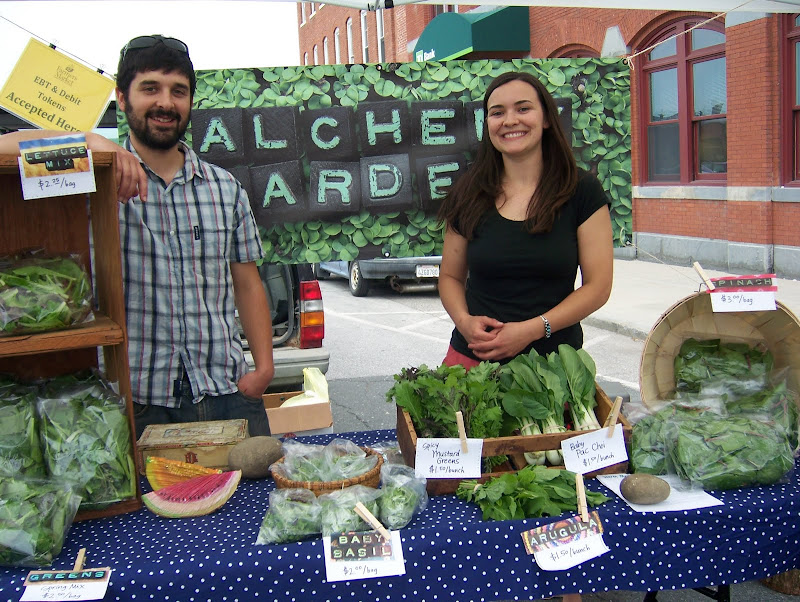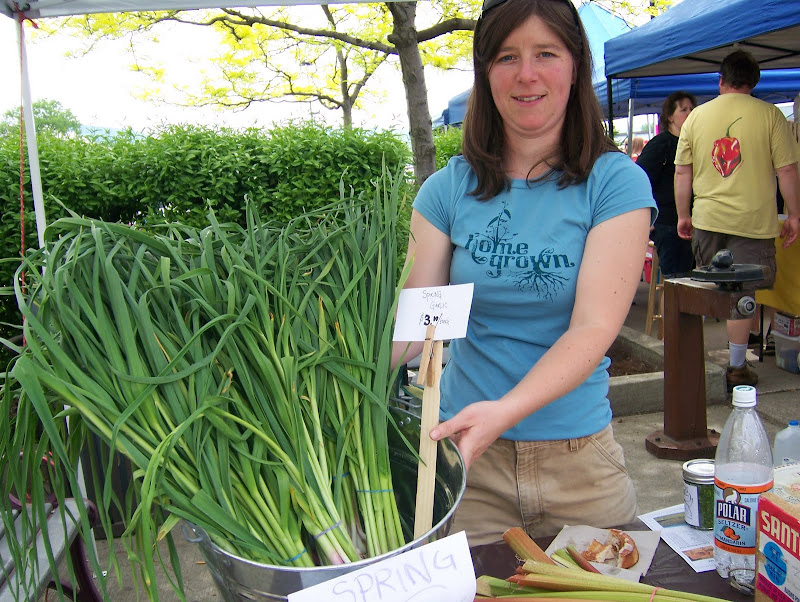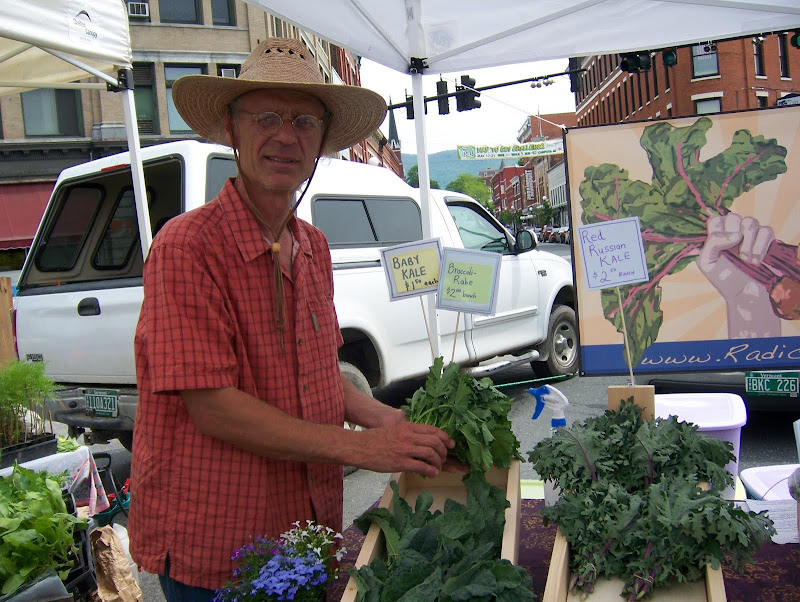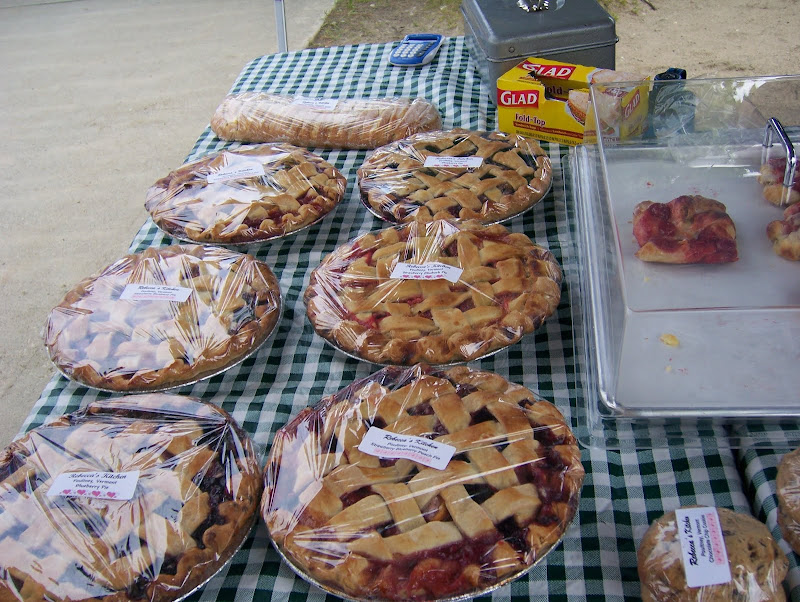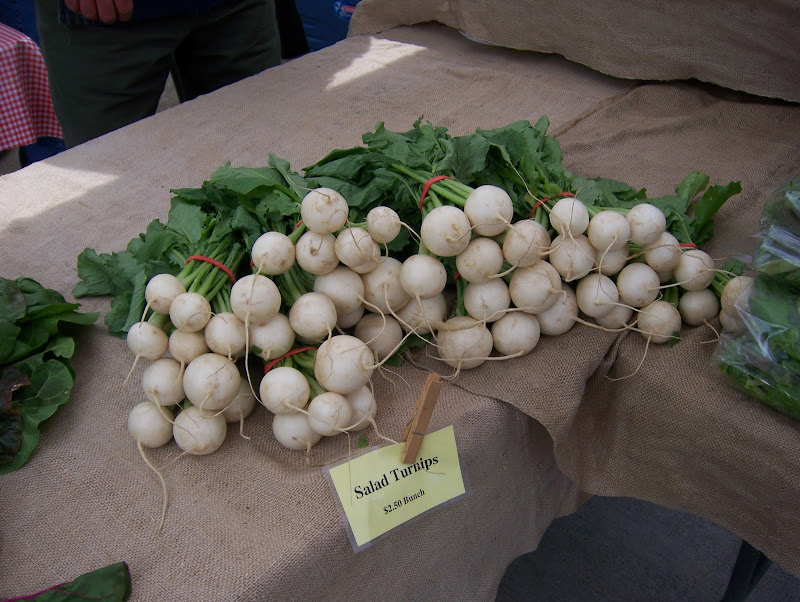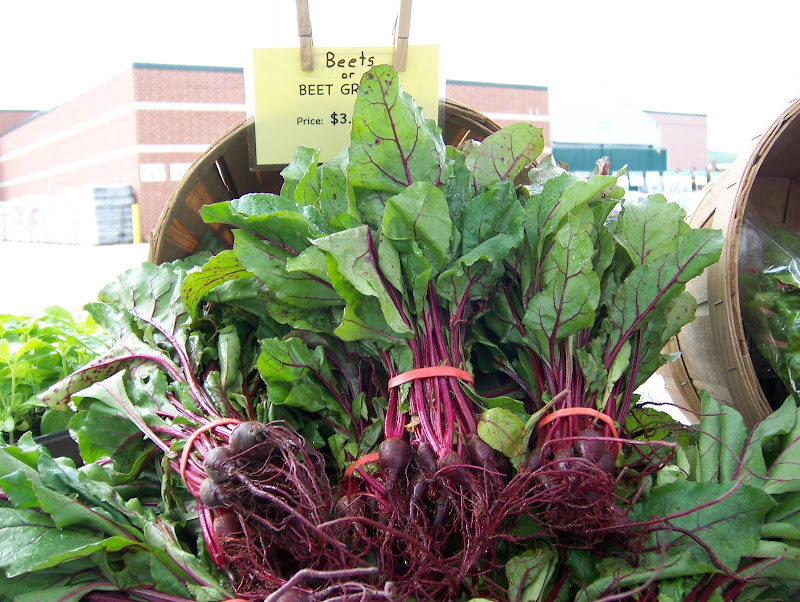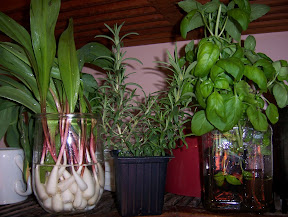We had radishes this year! It's always been a joke that the mayor will throw out the first radish at the first Farmers' Market, and someone has to go over to the supermarket to buy one! This year we had a splendiferous display of radishes – most notably at Foggy Meadow's stand – and the Herald got a great photo of young Ben Horton and those radishes to display on the front page.
As difficult as it is to be transported when you are hunching against the rain, racing through mud, icy rivulets streaming down your neck and up your sleeves, we shoppers managed it, and were able to greet some great new vendors as well as all the old beloved ones.
Here are a few of the former and one of the latter.
***
Lindsay Arbuckle and Scott Courcelle are new vendors this year, and their Alchemy Garden stand is a work of art, so beautiful that you might not gather how much sweat of the brow it demanded and got. From their smiles and easy-going manner it seems that it effortlessly, as its name suggests, sprang into being.
Not so, though, as the Arbuckle/Courcelle duo are busy people who are also the managers of the new co-op at Pierce's Store in Shrewsbury. No doubt they were able to polish their farming talents when they acted as Paul Horton's interns last summer at Foggy Meadow Farm in Benson, and they're putting those skills into practice now that they farm/garden on a piece of land at Greg Cox's Boardman Hill Farm in West Rutland. Lindsay also coordinated this year's Locally Grown Guide (just out – look for it) for RAFFL.
Note the lovingly-created seed packets and signs by Lindsay. Whew, that lady is a busy bee!
***
Another new vendor is Larson Farm from Wells, selling, most notably, pasture-raised veal. Some of you readers have asked about humanely raised veal, and here it is. It is rosy colored, very tasty. I made cutlets out of it last week, pounded thin, lightly breaded, sauteed in butter and olive oil.
Erin Seward woman's the enterprise, and brings along, so far, her own wildcrafted ramps, fiddleheads and, these few weeks green garlic.
Probably many people don't realize that garlic can be eaten at any stage of the game. Right now it is simply bulbous, like a scallion, so tender it can be eaten all the way up the stem. Soon you will find cloves being formed, the outer skin toughens, and the skin surrounding the individual cloves easily splits to uncover the tender cloves inside.
Erin also offers a pesto, made out of green garlic, and homemade hummus. Soon she will add her own garden-grown produce.
One of the things that is most heartening about these new vendors is the pure joy they take in what they're doing.
***
This splendid new vendor is Radical Roots Farm. We have watched Dennis Duhaime and Carol Tashie all this long spring sweating it out on their land out on Creek Road. That sweat has paid off with, among other things, broccoli raab at the very first market on May 8.
Now there's a story behind that raab that dates back to when Dennis was the Co-op's produce manager and I urged him to get some in, offering to do a tasting of it if he would. It's one of my favorite vegetables but most people had never heard of it. Dennis fell in love with it and now, finally, we have it available at Market.
Here's the way I wrote about its preparation last year:
….. toss the raab into boiling salted water and bring it just back to boiling, hold it there maybe a second more, then drain it. In the meantime you’ve warmed about a quarter of a cup of olive oil in a sauté pan with a finely chopped clove of garlic. When the raab is drained, and the garlic has had time to flavor the olive oil without turning a bit brown, turn the heat to high under the pan, and when the oil is hot (don’t let that garlic turn) throw in the raab and shake, rattle and roll until the raab is hot, has cooked a couple minutes more and is, my goodness, coated with the oil. Sprinkle with salt to taste, then a teaspoon or so of hot pepper flakes, and there we go! Serve it warm or even cold, or put it in a sandwich of crusty whole-grained bread.
Don't you love that sign? It's the work of Carol's brother.
Carol and Dennis also had the earliest regular broccoli ever on May 22. Here's Carol with it in her hands.

***
Not a new vendor but one of my favorite old ones is Rebecca Worthing of Poultney who offers her incredible made-from-scratch-and-lots-of-butter pastries almost every week, winter AND summer at her Rebecca's Kitchen stand at the Market. They're fresh each day! You know what this means? She's up most of the night before Market.The reason I haven't written about her before or even, I think, mentioned her, is that I was saving her for a feature article. Well, I just don't seem to get around to features anymore, so it's high time to tell you how wonderful she is while I'm writing about other wonderful people.
My favorite is that bearclaw. I've never eaten better – flaky and rich and perfectly balanced between shaley savory crust and nutty, sweet filling. Perhaps an interesting sidelight here: a year or so ago I asked Rebecca how she made her pie crusts. She uses sweet butter in everything else, but she said that was too expensive for pie crusts so she used a no-trans-fat shortening. I was probably visibly disappointed, because, as you all know, I advocate for natural fats – preferably half butter and half lard in my crusts – and she was also visibly distressed, as any artist is at even a hint of criticism.
Recently, though, she confessed to me that she had taken my advice, and now all her pastries, including pies, are butter rich. Right on, Rebecca.
She picks all of her berries and apples fresh and in season. She has a young family, too. I don't think she sleeps, ever.
***
What else is new at the Farmers' Market?These lovely little salad turnips (from Foggy Meadow) are exquisite out of hand – halfway between a radish and an apple; sweet and juicy – or simmered slowly in butter, with a bit of tarragon, along with their greens. What an unctuous, sweet, meltingly fresh, lovely vegetable this is, either alone or curled around a perfectly grilled porkchop.
And these beauteous young beets:
Really, there's nothing better in spring than young beets and greens. Last night I cut the stems about 2 inches long and simmered the beets until they were almost tender – for as little as 10 minutes, really – then added the greens to the pot and simmered for perhaps 10 minutes more. I drained them, slipped the skins from the beets (but saved the stems), and added the quartered beets, stems, and greens to a saute pan in which I had steeped over a low flame some fresh green garlic in a plethora of olive oil, turned the heat up a bit and tossed just until the beets had absorbed that lovely, garlicky oil.
At that point I may have sprinkled them with a few drops of vinegar, showered them with grated hard-boiled egg, salted and peppered them, or strewn them with hot pepper flakes, but whatever I did (and I've done all for different suppers this month), they all satiate the soul!
***
Okay. What's missing here? Oh, of course, Greg Cox, the Grand old Man of the Farmers' Market, the Philosopher-Farmer. Where's Greg?
Well, Greg's recuperating from long-delayed and well-deserved knee surgery!
About time you took care of those knees, Old Man! You're going to need them for many years to come, and maybe now that you're pain-free and agile as a gazelle you'll quit grumbling like an old bear and accomplish even more for Rutland and its food and farmers!
***
Satiate the soul. Hie yourself to the Farmers' Market wherever you be!

